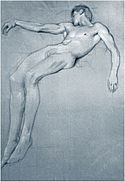| Revision as of 01:38, 17 January 2013 editBG19bot (talk | contribs)1,005,055 editsm WP:CHECKWIKI error fix for #61. Punctuation goes before References. Do general fixes if a problem exists. - using AWB (8855)← Previous edit | Revision as of 20:41, 17 January 2013 edit undoHam II (talk | contribs)Extended confirmed users, Pending changes reviewers56,297 edits better picNext edit → | ||
| Line 1: | Line 1: | ||
| {{Infobox Painting | {{Infobox Painting | ||
| | image_file= |
| image_file=Herbert Draper - The Lament for Icarus - Google Art Project.jpg | ||
| | image_size=250px | | image_size=250px | ||
| | title=The Lament for Icarus | | title=The Lament for Icarus | ||
Revision as of 20:41, 17 January 2013
| The Lament for Icarus | |
|---|---|
 | |
| Artist | Herbert James Draper |
| Year | 1898 |
| Type | Oil on canvas |
| Location | Tate Gallery, London |
The Lament for Icarus is a painting by Herbert James Draper, showing dead Icarus, surrounded by lamenting nymphs. The wings of Icarus are based on the bird-of-paradise pattern. In 1898 the painting was bought from the Royal Academy exhibition through The Chantrey Bequest, a public fund for purchasing modern art bequeathed by Sir Francis Leggatt Chantry, R.A.. The Lament for Icarus was subsequently awarded the gold medal at the Exposition Universelle of 1900 in Paris.
According to Dr. Justine Hopkins, Draper identifies Icarus "with the other heroes of the Pre-Raphaelites and symbolists, who, like James Dean half a century later, manage to live fast, die young and leave a beautiful corpse".
The composition

In 1890s Draper was focused mainly on ancient Greek mythological subjects. Frederic Leighton had depicted Icarus in 1869, but while Leighton showed the preparations for the flight, Draper depicted the tragical end of the flight. For the composition Draper adopted Leighton's method of depicting separate figures, for which he employed four young professional models (Ethel Gurden, Ethel Warwick, Florence Bird and Luigi di Luca).
The use of the male body as a vehicle for the projection of subjective emotion, as in The Lament for Icarus, is a feature of late-Victorian painting and sculpture, and in The Lament for Icarus the body appears to melt within the arms of one nymph. Draper applied liquid light effects without abandoning form and used mainly warm colors. The tanned skin of Icarus refers to his close approach to the Sun before falling down. The rays of the setting sun on distant cliffs emphasize the transience of time. Moralizing, sentimental and sensual, The Lament for Icarus ultimately became a well-composed image of epic failure.
Notes
- ^ Jacob E. Nyenhuis. Myth and the creative process: Michael Ayrton and the myth of Daedalus, the maze maker, Wayne State University Press, 2003, p. 54, ISBN 0-8143-3002-9
- "The Chantry Bequest">
- "Art Reproduction of Draper". Allartclassic.com. Retrieved 2010-11-19.
- ^ Alison Smith. Exposed: The Victorian Nude, Watson-Guptill, 2002